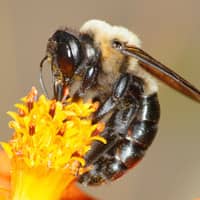
Carpenter Bees

Many bee species are very social and live in large colonies. Carpenter bees are not one of these species; they live alone, or in very small groups (mothers and daughters). Female carpenter bees create dime-sized holes into wooden things like siding, decks, sheds, play equipment, and lawn furniture. They use these holes to lay their eggs in. They prefer to make these nesting areas in unstained and unpainted softwood, but they will create holes in painted and stained wood as well. If several females attack the same piece of wood, the damage can be quite significant.
Identifying Carpenter Bees
Carpenter bees are a large bee species ranging in size from ½ an inch to 1 ½ inch in length. They are often mistaken for bumblebees, however, the main difference is the shiny abdomen of the carpenter bee. A bumble bee’s abdomen is completely covered in dense hair. Males have a white or yellow face and are often hovering near the nest, “guarding” it from predators. Males do not have stingers. Females generally have a completely black or brown face and have a stinger but are docile and will usually only sting if being handled.
The Life Cycle & Habits Of Carpenter Bees
This type of bee is not very social. Each female is responsible for laying her own eggs, however, from time to time females may invade the same piece of wood and even share their galleries. Females create their galleries by making a hole that is about their own width wide and about 25 mm long. They will then make a right turn borrowing along the grain of the wood. These galleries can be anywhere from 10 to15 mm to 3 meters long. If carpenter bees are currently active, you will notice sawdust or wood shavings on the ground.
Each gallery will have several compartments in it. The female carpenter bee will place pollen and other food in each compartment and lay an egg inside. She will then seal the compartment with a wood and saliva mixture. The eggs will develop into adults in 36-99 days. The females and her daughters will come back to the same area year after year to lay their eggs, increasing the damage that is done to the structure. Adult carpenter bees will use empty tunnels to overwinter in.
Carpenter Bee Damages
The tunneling activities of carpenter bees can cause wood to weaken over time but it is also woodpeckers that peck away at the wood to get to the eggs inside that can also cause significant damage to wood structures.
Carpenter Bee Control
For carpenter bee control, contact a pest control company that has the tools, knowledge, and experience to address this type of pest problem. Contact American Pest Solutions today to find out how our pest control professionals can exterminate your bee problem.
Carpenter Bee Prevention
To discourage carpenter bee activity around your home or business, we highly recommend painting or staining any wood that is used on the structure as well as porches, decks, and sheds. You may also consider using hardwood as opposed to softwood when building.

Trust Massachusetts' oldest family owned pest control company to protect your family & home.